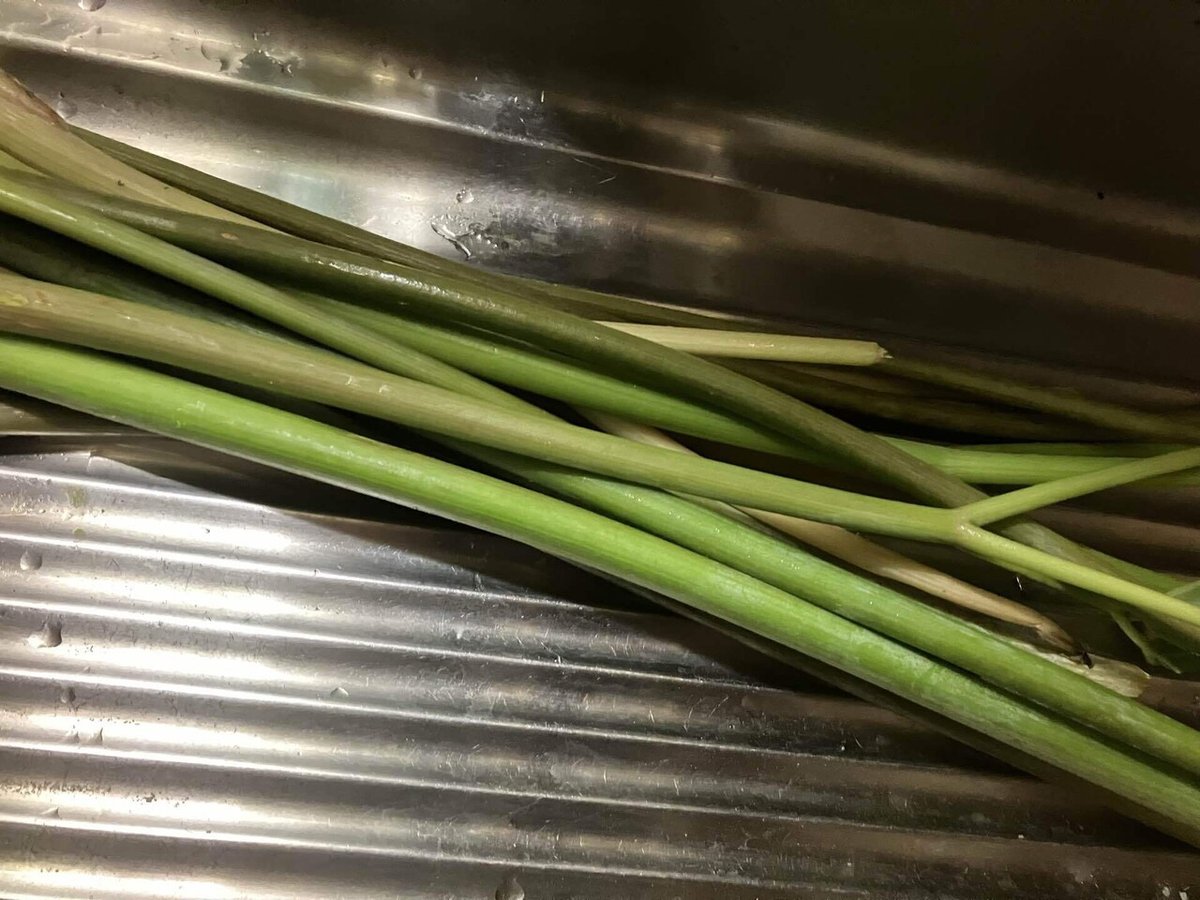
明日葉の茎の甘辛二重奏 Sweet and spicy duet of ashitaba angelica stems
常備菜研究室
Preserved Food Laboratory
ストーリー
Recipe trivia
前の記事で、雑草化している明日葉の葉のレシピを紹介したけど、実は使わなかった茎が残っている。明日葉の葉を収穫しないでおくと1メートル近くまで茎が成長する。実はこの茎はとても美味しいのだ。
ただ、雑草化した野生種ならではの問題がある。明日葉は単一種と言われているが、厳密にいうと2つの亜種らしきグループに分かれる。赤い茎グループと青い茎グループの2つだ。青茎種の方は柔らかくて癖なく美味しいのだけど、赤茎種の方は、ちょっと灰汁があって皮も硬いのだ。栽培種は青茎種のみを選別して出荷しているので、意識する必要はないのだけど、野生種はそうはいかない。赤茎種と青茎種は簡単に交雑してしまうので、見かけで分からなくなってしまう。だから収穫した茎を調理すると、柔らかすぎたり、硬かったり、均一に仕上がらない。そこで、最初はこの混成の素材を一緒に茹でて、硬さを見てから、途中で2つの料理に分岐させるようにした。ユニゾンで始まった曲が中途で2つのパートに分かれる如く。だから、このレシピは2品の複合レシピになっている。
In the previous article, I introduced a recipe for using the leaves of the weedy ashitaba, but I did not use the stems. If the leaves of the ashitaba are not harvested, the stems will grow to nearly one meter. In fact, these stems are very delicious.
However, there are problems unique to wild species that have become weeds. Although ashitaba is said to be a single species, strictly speaking, it is divided into two groups that seem to be subspecies. There are two groups: the red stem group and the green stem group. The green stem group is soft and has a pleasant taste, but the red stem group has a bit of bitterness and a hard skin. Since only the green stem group is selected and shipped for cultivation, there is no need to be aware of this, but this is not the case with wild species. The red stem group and the green stem group easily crossbreed, so it is difficult to tell by appearance. Therefore, when the harvested stems are cooked, they are either too soft or too hard, and the cooking is not uniform. Therefore, I decided to boil these mixed stems together at first, check the hardness, and then later split them into two dishes. Like a song that starts in unison and then splits into two parts halfway through. So this recipe is a combination of two dishes.
柔らかい個体を使ったレシピはお浸し。明日葉の茎は蕗の茎のように見えるが、実はずっと柔らかいし、蕗よりも癖がない。伽羅煮にしないで、薄味で滋味を味わう方が良い。以前、アスパラガスで方法論を示したが、同じやり方でお浸しにした。
硬めの個体を使うレシピは、伽羅蕗でも良いのだけど、あえて砂糖煮にした。実はこの明日葉は、学名を見るとすぐ分かるが、セリ科シシウド目で、アンジェリカ(西洋当帰)のごく近縁種なのだ。アンジェリカの茎は砂糖煮にしてケーキなどに使われる。フルーツケーキなどに刻み込まれている緑色に着色された砂糖煮がそうだ。キク科の蕗で無理やり代用するより、こっちの方がずっと近い味になる。ちなみにアンジェリカは天使(エンジェル)が語源で、ヨーロッパでは天使のハーブと呼ばれ、料理、お菓子、お酒にも使われている。漢方薬の当帰もこのシシウド目だ。
The recipe that uses the soft stem is a soaked dish. The stem of the angelica leaf looks like the stem of a butterbur, but it is actually much softer and has a milder flavor than butterbur. It is better to enjoy the flavor with a light seasoning rather than making it tsukudani (cooked salty with dark soy stype auce). I previously showed the method using asparagus, and I made it in the same way.
The recipe that uses the harder stems can be made with tsukudani, but I chose to make it sugar-cooked. In fact, as you can see from the scientific name, this angelica leaf is in the Apiaceae family, the Angelica order, and is very closely related to angelica. Angelica stems are cooked in sugar and used in cakes. The green-colored sugar-cooked ones that are carved into fruit cakes are an example. This tastes much closer than trying to substitute it with butterbur from the Asteraceae family. Incidentally, angelica comes from the word angel, and in Europe it is called the angel herb, and is used in cooking, sweets, and alcohol. The Chinese herbal medicine Angelica dahurica also belongs to the Angelica family.
Ingredients:
材料:
採集した明日葉の茎(市販品で良い)
昆布
薄口醤油
上白糖(色見を気にしない用途なら、黒糖でも良い)
Harvested angelica stems (commercially available ones are fine)
Konbu kelp
Light type soy sauce
White sugar (if you don't care about the color, brown sugar is fine too)
procedure:
手順:
明日葉の茎を洗って、鍋に入る大きさに切り分ける。
鍋にお湯を沸かして、明日葉の茎を入れ、3、4分茹で、冷水に取る。
指で一本づつ硬さを確認し、柔らかい茎と硬い茎とを選別する。
Wash the ashitaba stems and cut them into pieces that will fit into the pot.
Bring a pot of water to a boil, add the ashitaba stems, and boil for 3 to 4 minutes, then transfer to cold water.
Check the firmness of each stem with your fingers, and separate the soft stems from the hard ones.




容器を用意して昆布を敷き、ミネラルウオーター(ないし沸騰させて冷ました水)を注いで、薄口醤油で味付けをしておく。
柔らかい茎の皮を剥いて(皮も柔らかければ剥く必要はない。新鮮な市販品の明日葉の茎は皮を剥かなくても十分柔らかい)、容器に漬け込む。
30分くらいで食べられるが、冷蔵庫で一晩置くと、味が染みてより美味しい。
味が染みたら、一口大に切り分けて、提供する。
冷蔵庫で4、5日は保存が可能。
Prepare a container, lay the kelp on top, pour in mineral water (or boiled and cooled water), and season with light soy sauce.
Peel the soft stems (if the skin is soft there is no need to peel it. Fresh, commercially available ashitaba stems are soft enough that you don't need to peel them) and place them in the container.
They can be eaten in about 30 minutes, but leaving them in the refrigerator overnight will allow the flavors to soak in and make them even more delicious.
Once the flavors have soaked in, cut them into bite-sized pieces and serve.
It can be stored in the refrigerator for 4 to 5 days.


硬めの茎は、皮を剥いてから、30分ほど水に晒し、一口大に切り分けて鍋に入れる。
ひたひたの水を注ぎ、素材と同重量の砂糖を入れて、弱目の火で、かき混ぜながら煮詰める。
水分がほとんどなくなったら、砂糖をまぶして冷まし、保管する。
冷蔵庫で1月ほど、保存が可能。
Peel the tougher stems and soak them in water for about 30 minutes, then cut them into bite-sized pieces and place them in a pot.
Pour in water until they are completely covered, add sugar equal in weight to the ingredients, and simmer over low heat while stirring.
Once most of the water has evaporated, sprinkle with sugar, cool, and store.
They can be stored in the refrigerator for about a month.






Tips and tricks:
コツと応用のヒント:
明日葉の、青茎種だけの野生の群生地が見つかるか、市販品が手に入った時は、この選別は不要なので、それぞれのレシピで、作りたい量を作れば良い。
お浸しは、滋味を生かすため、あえて薄口醤油のみを使っているけど、好みで濃口醤油を使っても構わない。また、味を濃くしたいなら、動物性の出汁や化学合成出汁を使っても良い。
癖も味のうちなので、硬めの茎の方は齧ってみて、気にならないのなら、水に晒す必要はない。
明日葉の砂糖煮は、そのまま食べても良いし、フルーツケーキに入れたり、クッキーのトッピングに使うと良い。自然の色が寂しければ、市販のアンゼリカ砂糖漬けのように着色しても良い。
If you can find a wild colony of ashitaba with only the green stems, or if you can get it commercially available, this selection is not necessary, so you can just make the amount you want for each recipe.
For the ohitashi(soaked ashitaba stem), I deliberately used only light type soy sauce to bring out the flavor, but you can use dark type soy sauce if you prefer. Also, if you want a stronger flavor, you can use animal broth or synthetic broth.
The strong flavor is part of the taste, so try biting into the tougher stems, and if it doesn't bother you, there's no need to soak them in water.
You can eat ashitaba in sugar as is, or add it to fruit cake or use it as a cookie topping. If the natural color is dull, you can color it like commercially available candied angelica.
Guide to where to get ingredients and equipment 材料と機材の入手先ガイド
※Amazonのアフェリエイトに参加しています。もしご購入の際はここからクリックしてご購入いただけると、コーヒー代の足しになるので、嬉しいです。ちなみに僕はコーヒー依存症です。
*I participate in Amazon affiliate programs. If you purchase this product by clicking here, it will help pay for my coffee, so I would be very happy. By the way, I am addicted to coffee.
この記事が気に入ったらサポートをしてみませんか?
